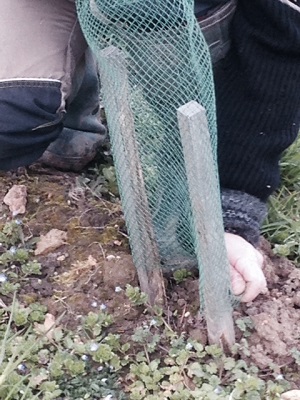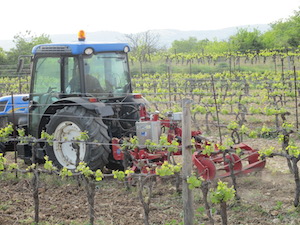At the beginning of this year, and with particular reference to the cold spell that we have had over the past few weeks, the winemakers have been talking to us lots about the importance and the benefits of the vines resting during winter. During the cold winter months, the sap descends into the roots to help protect the vines. This article looks at the role of the vine roots, and their importance on the vegetative life cycle.
First of all, what are the roots?
A vine is made up of two parts. The top part that is above ground is a graft of the vitis vinifera, and the part below ground that is a rootstock, often a hybrid between American and vitis vinifera species that are resistant to phylloxera, a disease that ravaged the European vineyards in the 1860s.
Since the phylloxera crisis, it is very rare that vines are planted “franc de pied”, that is without being grafted to a rootstock that is resistant to phylloxera. The roots are the part of the rootstock that are under ground and bring the necessary nutrients to the plant.
What role do the roots play?
The vine roots have multiple functions. Firstly, they serve to anchor the plant to the soil. They also absorb water and the minerals necessary for the vines development. And lastly, they also have a role to support the vegetative growth in spring. After the harvest, photosynthesis continues, and carbohydrate reserves are produced and stored in the vine trunks and roots for winter and spring.

How deep do the roots go?
A vine has three levels of roots that reach down 2 – 5 metres on average, and they can descend much further if needed. The principal roots are those which already exist when the vine was planted. Then the secondary roots form and from these the rootlets or very fine roots grow. These rootlets are produced each year, and the rootlets which age then become secondary roots.
The depth to which the roots grow depends on many factors such as the type of rootstock used, the soil type which can be more or less compact and deep, the density of vines planted, and how the soil is worked by the winemaker. And also the older a vine is, the deeper the roots generally penetrate.
Are the roots impacted by the weather?
We often hear that vines are robust plants, which generally speaking is true. The winemaker must however help to protect them, particularly when they are young and their root system hasn’t yet developed deep enough to protect themselves.
To protect against the cold in the vineyards that are the most exposed, once the leaves have fallen from the vines, the winemaker will heap soil around the base of the vines to help the shallowest roots be better protected against the frost. A short period of sustained cold temperatures during winter is one of the best protections against disease for the vines as many of the bacteria that reside in the soil are killed off.
Vines don’t like too much humidity. Some rain is beneficial during the growth of the vine and when the grapes are maturing, but it is best that they avoid being stood in water. Too much stagnant water causes disease to form and spread through the soil.
Drought is less of a problem for vines, particularly if the roots are well developed and are deep enough to find water and the necessary nutrients. Having said that, in certain southern vineyards, if it doesn’t rain enough in spring to replenish the underground water table, the winemakers can be obliged to irrigate.
And if drought strikes, it’s not the roots that suffer first, but the fruit, because the plant will always favour its overall survival over producing fruit. Nature is well done, even if it sometimes disappoints the winemakers!
How do you protect the roots in organic or bio-dynamic wine-making?
As previously mentioned, vines are pretty resistant to the climate, but what they do fear is disease, particularly those that are spread throughout the soil. Two of the most common are root rot, a parasitic disease, and phylloxera, a sap sucking insect that can cut off the flow of nutrients and water to the vine. These illnesses can cause the vine to die, and the symptoms only appear late, once the contamination has set in.
You therefore have to act preventively, particularly in organic or biodynamic winegrowing where you cannot easily treat the vines once the illness has struck. To have as healthy a soil as possible, the surface is tilled regularly to aerate the soil and thus encourage the microbial life.

In biodynamics, the health of the plant is thought to pass directly from the soil, so in biodynamic winegrowing the general aim is to restore and enhance the organic life in the surrounding environment of the vines. By improving the natural exchange between the soil and the roots, you can help to enhance the vitality and resistance of the plants.
The majority of winemakers who have changed to organic or biodynamic methods have noted the development of a better root structure, and better qualitative and quantitative results over time.
Winter is a time of rest for the vines. Nothing happens in the part above ground where the sap no longer circulates. The sap descends into the foot and roots to prepare for spring and to develop the reserves necessary for the future grapes.
Related articles
End of the winter holidays... for the vines
Bud burst of the vines in Spring
What is biodynamic wine?
Comments
-
Thanks for this precise information concerning the depth of vine roots.





Envoyé le Vendredi 26 June 2020 by Jose